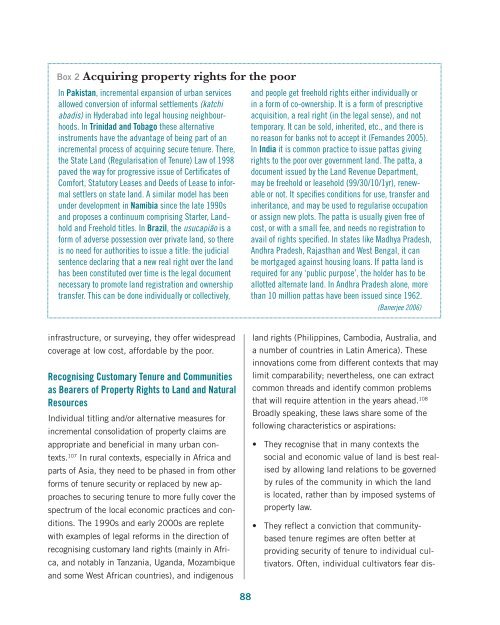Download the file - United Nations Rule of Law
Download the file - United Nations Rule of Law
Download the file - United Nations Rule of Law
You also want an ePaper? Increase the reach of your titles
YUMPU automatically turns print PDFs into web optimized ePapers that Google loves.
Box 2 Acquiring property rights for <strong>the</strong> poorIn Pakistan, incremental expansion <strong>of</strong> urban servicesallowed conversion <strong>of</strong> informal settlements (katchiabadis) in Hyderabad into legal housing neighbourhoods.In Trinidad and Tobago <strong>the</strong>se alternativeinstruments have <strong>the</strong> advantage <strong>of</strong> being part <strong>of</strong> anincremental process <strong>of</strong> acquiring secure tenure. There,<strong>the</strong> State Land (Regularisation <strong>of</strong> Tenure) <strong>Law</strong> <strong>of</strong> 1998paved <strong>the</strong> way for progressive issue <strong>of</strong> Certificates <strong>of</strong>Comfort, Statutory Leases and Deeds <strong>of</strong> Lease to informalsettlers on state land. A similar model has beenunder development in Namibia since <strong>the</strong> late 1990sand proposes a continuum comprising Starter, Landholdand Freehold titles. In Brazil, <strong>the</strong> usucapião is aform <strong>of</strong> adverse possession over private land, so <strong>the</strong>reis no need for authorities to issue a title: <strong>the</strong> judicialsentence declaring that a new real right over <strong>the</strong> landhas been constituted over time is <strong>the</strong> legal documentnecessary to promote land registration and ownershiptransfer. This can be done individually or collectively,and people get freehold rights ei<strong>the</strong>r individually orin a form <strong>of</strong> co-ownership. It is a form <strong>of</strong> prescriptiveacquisition, a real right (in <strong>the</strong> legal sense), and nottemporary. It can be sold, inherited, etc., and <strong>the</strong>re isno reason for banks not to accept it (Fernandes 2005).In India it is common practice to issue pattas givingrights to <strong>the</strong> poor over government land. The patta, adocument issued by <strong>the</strong> Land Revenue Department,may be freehold or leasehold (99/30/10/1yr), renewableor not. It specifies conditions for use, transfer andinheritance, and may be used to regularise occupationor assign new plots. The patta is usually given free <strong>of</strong>cost, or with a small fee, and needs no registration toavail <strong>of</strong> rights specified. In states like Madhya Pradesh,Andhra Pradesh, Rajasthan and West Bengal, it canbe mortgaged against housing loans. If patta land isrequired for any ‘public purpose’, <strong>the</strong> holder has to beallotted alternate land. In Andhra Pradesh alone, morethan 10 million pattas have been issued since 1962.(Banerjee 2006)infrastructure, or surveying, <strong>the</strong>y <strong>of</strong>fer widespreadcoverage at low cost, affordable by <strong>the</strong> poor.Recognising Customary Tenure and Communitiesas Bearers <strong>of</strong> Property Rights to Land and NaturalResourcesIndividual titling and/or alternative measures forincremental consolidation <strong>of</strong> property claims areappropriate and beneficial in many urban contexts.107 In rural contexts, especially in Africa andparts <strong>of</strong> Asia, <strong>the</strong>y need to be phased in from o<strong>the</strong>rforms <strong>of</strong> tenure security or replaced by new approachesto securing tenure to more fully cover <strong>the</strong>spectrum <strong>of</strong> <strong>the</strong> local economic practices and conditions.The 1990s and early 2000s are repletewith examples <strong>of</strong> legal reforms in <strong>the</strong> direction <strong>of</strong>recognising customary land rights (mainly in Africa,and notably in Tanzania, Uganda, Mozambiqueand some West African countries), and indigenousland rights (Philippines, Cambodia, Australia, anda number <strong>of</strong> countries in Latin America). Theseinnovations come from different contexts that maylimit comparability; never<strong>the</strong>less, one can extractcommon threads and identify common problemsthat will require attention in <strong>the</strong> years ahead. 108Broadly speaking, <strong>the</strong>se laws share some <strong>of</strong> <strong>the</strong>following characteristics or aspirations:• They recognise that in many contexts <strong>the</strong>social and economic value <strong>of</strong> land is best realisedby allowing land relations to be governedby rules <strong>of</strong> <strong>the</strong> community in which <strong>the</strong> landis located, ra<strong>the</strong>r than by imposed systems <strong>of</strong>property law.• They reflect a conviction that communitybasedtenure regimes are <strong>of</strong>ten better atproviding security <strong>of</strong> tenure to individual cultivators.Often, individual cultivators fear dis-88
















